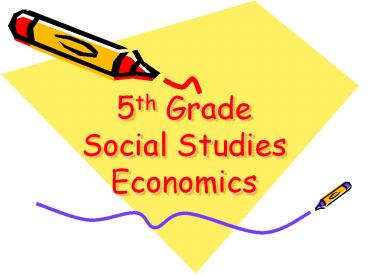5th Grade Social Studies Economics - PowerPoint PPT Presentation
1 / 18
Title:
5th Grade Social Studies Economics
Description:
5th Grade Social Studies Economics 1. People play different roles in economics__producer, provider, consumer, and investor. The person working at a grocery store is a ... – PowerPoint PPT presentation
Number of Views:1153
Avg rating:3.0/5.0
Title: 5th Grade Social Studies Economics
1
5th GradeSocial StudiesEconomics
2
- 1. People play different roles in
economics__producer, provider, consumer, and
investor. The person working at a grocery store
is a - A. producer.
- B. provider.
- C. consumer.
- D. investor.
3
2. What is the definition of "economics"?
- A. the study of human behavior and attitudes
- B. the study of past events and the impact they
have had on people - C. the study of political and social interactions
- D. the study of the production and distribution
of goods and services
4
- 3. Trade is the exchange of goods and services.
International trade sometimes involves the use of
tariffs. Tariffs are - A. a tax on imports.
- B. goods shipped to a country.
- C. a tax on exports.
- D. goods shipped from a country.
5
4. In economics, there are imports and exports.
An import is
- A. merchandise shipped to a foreign country.
- B. a tax on goods shipped to a foreign country.
- C. merchandise shipped from a foreign country.
- D. a tax on goods shipped from a foreign country.
6
- 5. The westward migration (movement) of settlers
during the 1800s greatly affected the lives of
Native Americans. Which statement describes one
way in which Native Americans were affected? - A. Native Americans began to hunt buffalo rather
than grow crops. - B. Native Americans grew wealthy from trade with
white settlers. - C. Native Americans were forced off their land.
- D. Native Americans moved away from reservations.
7
6. There are many different types of economic
systems. The United States economy is based on a
- A. free enterprise system.
- B. communist system.
- C. socialist system.
- D. traditional system.
8
7. The factors of production is a term used for
all the elements that go together to produce
goods and services. Which factor of production is
the term used to describe natural resources?
- A. land
- B. labor
- C. capital
- D. consumption
9
8. People have different roles in our economic
system__producer, provider, consumer, and
investor. The person who buys stock in a company
is
- A. an investor.
- B. a consumer.
- C. a provider.
- D. a producer.
10
9. During the 1800s, the Industrial Revolution
changed America. A major change that happened
because of the Industrial Revolution was an
increase in goods that were
- A. made in factories instead of in small shops
and homes. - B. sold in small stores and shops.
- C. made in small shops and homes instead of in
factories. - D. sold in large stores and businesses.
11
10. Which of the following is an example of
economics?
- A. The government of the United States is divided
into three branches. - B. The United States declared its independence
from Great Britain. - C. The people of the United States come from many
different places. - D. The United States buys oil for use at home
from other countries.
12
11. Both natural resources and human resources
are used in economics. Which of the following is
an example of a natural resource?
- A. water
- B. workers in a factory
- C. investors in a company
- D. money
13
12. The things needed to produce goods and
services are called the factors of production.
The factors of production include capital
(machines), labor, and
- A. government decisions.
- B. workers' skills.
- C. land resources.
- D. buyers' needs.
14
13. Which of the following situations will MOST
LIKELY make the price of an item go down?
- A. The price of the natural resources needed to
make the item increases. - B. The supply of the item is greater than the
demand for it. - C. The price of the labor needed to make the item
increases. - D. The demand for the item is greater than the
supply of the item.
15
14. Land, labor, and capital (machines) are used
to produce goods and services. These are known as
- A. natural resources.
- B. the laws of consumption.
- C. the law of supply and demand.
- D. the factors of production.
16
15. A factory makes 100 cars a day. They sell
quickly, and dealers have lists of people wanting
to buy the car. The factory owner decides to hire
more workers and make 150 cars a day. This is an
example of
- A. buying and bartering.
- B. specialization.
- C. supply and demand.
- D. mechanization.
17
Answer Key
18
- 8. A) an investor. 9. A) made in factories
instead of in small shops and homes. 10. D) The
United States buys oil for use at home from other
countries. 11. A) water 12. C) land
resources. 13. B) The supply of the item is
greater than the demand for it. 14. D) the
factors of production. 15. C) supply and demand.
- 1. B) provider. 2. D) the study of the
production and distribution of goods and services
3. A) a tax on imports. 4. C) merchandise
shipped from a foreign country. 5. C) Native
Americans were forced off their land. 6. A)
free enterprise system. 7. A) land

